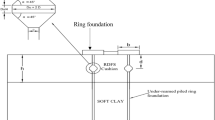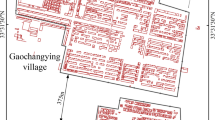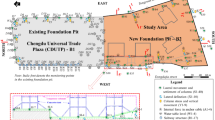Abstract
We study grouting effects of soft and crushing floors using the Fenyuan Coal Company’s mine as an experimental mine. We employ physical exploration, hole inspection, the permeability coefficient, and P-Q-t to evaluate the grouting effects of floor undulation while water inflows are monitored. The results show that the rich water area disappears and builds resistance after grouting. The integrity of the floor strata is improved, and inflows of water into the hole are reduced by 93.3% after grouting. The permeability coefficient of the strata is measured as 1.62 × 10–5 ~ 1.74 × 10–5 cm/s after grouting, the number of fractures is reduced to 35, and fracture widths are significantly decreased after grouting. Inflows of water through the face remain as 60 m3/h less than the drainage capacity of the face and thus meet safe mining requirements.










Similar content being viewed by others
References
Bellendir EN, Aleksandrov AV, Zertsalov MG (2016) Building and structure protection and leveling using compensation grouting technology[J]. Power Technol Eng 50:142–146
Cheng AP, Gao YT, Liang XW, Ji MW, Wang CW, Gao YH (2014) Dynamic forecasting of mining-induced failure depth of floor based on unascertained clustering method. J Min Saf Eng 31:739–744
Eng MB, Bonanno M, Rigazio A (2014) Consolidation grouting using horizontal directional drilling technology in the Praga district of Warsaw prior to TBM tunneling. Geomech Tunnelling 7:248–254
Haftani M, Gheshmipour AA, Mehinrad A, Binazadeh KH (2014) Geotechnical characteristics of bakhtiary dam site, sw iran: the highest double curvaturedam in the world. Bull Eng Geol Environ 73:479–492
Heidari M, Tonon F (2015) Ground reaction curve for tunnels with jet grouting umbrellas considering jet grouting hardening. Int J Rock Mech Min Sci 76:200–208
Kociánová M, Drochytka R, Černý V (2016) Technology of remediation of embankment dams by optimal grout. Procedia Eng 151:257–264
Kogler K (2013) Grouting technology in tunnelling/Injektionstechnik im Tunnelbau Geomechanik und Tunnelbau. Geomech Tunnelling 6:261–273
Ma D, Bai HB (2015) Groundwater inflow prediction model of karst collapse pillar: a case study for mining-induced groundwater inrush risk. Nat Hazards 76:1319–1334
Sahu L, Dey S (2017) Enrichment of carbon recovery of high ash coal fines using air fluidized vibratory deck separator. Int J Coal Sci Technol 4:1–12
Wu HZ, Jiao YY, Li HB, Zhang XL (2008) Technical method of ground penetrating radar for detecting grouting effect of air-raid shelter and its application. Rock Soil Mech 29:207–310
Zolfaghari A, Bidar S, Maleki Javan MR, Haftani M, Mehinrad A (2015) Evaluation of rock mass improvement due to cement grouting by Q-system at Bakhtiary dam site. Int J Rock Mech Min Sci 74:38–44
Author information
Authors and Affiliations
Corresponding authors
Rights and permissions
About this article
Cite this article
Wang, X., Qin, Q. & Fan, C. Research on comprehensive evaluation for grouting effect of broken and soft floor. Arab J Geosci 10, 420 (2017). https://doi.org/10.1007/s12517-017-3198-3
Received:
Accepted:
Published:
DOI: https://doi.org/10.1007/s12517-017-3198-3




